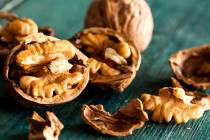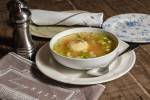Chefs use mustard’s universal appeal
Josh Crain, chef de cuisine of Bouchon Bistro at The Venetian, grew up in central Illinois and didn’t know much about mustard beyond the yellow stuff.
“I’d see Grey Poupon commercials, but I didn’t know what the hell that was,” he said.
Eventually, he would.
“Fifteen years ago, I learned about Dijon,” Crain said.
That’s when he went to work at Bouchon, which reflects the bistro style of cuisine in France.
“You sit down and there’s always a mustard pot on the table,” he said of dining in France.
Bouchon takes a fairly traditional approach, and that extends to their mustard, Crain said.
“It’s always been a staple in the kitchen,” he said. “Just as we have butter everywhere, there would always be mustard.”
Mustard may seem like a sort of culinary afterthought — stuff you squirt on your hot dog or ham sandwich — but chefs say it’s a vital component in many dishes. And they’re finding ever more creative ways to use it.
“Mustard is absolutely everywhere in the world,” said Tom Ryan, founder/owner of the Smashburger and Tom’s Urban chains. “Every cultural, iconic food has some component of mustard in it. It is a universally appealing flavor to people.
“It’s not surprising you would find it not just around for a long time but something that’s gone the way of craft; the resurgence of eating simple food with simple condiments is one of the growing things.”
Local chefs use mustard widely with their charcuterie trays, but also as a flavoring agent, thickening agent and in some more offbeat uses.
“There’s an acidic nature to mustard,” Crain said, “a similar use to how we as cooks would use vinegars. When finishing ragouts and certain sauces, acid brightens flavors. Mustard can do the same thing.”
In vinaigrettes, he said, the mustard balances the vinegar. Their house vinaigrette is a simple mixture of red wine vinegar, Dijon mustard and canola oil, he noted.
Crain and Bouchon favor Edmond Fallot mustards.
“The Fallot has a bigger bite than a lot of other Dijon mustards,” he said, “so you don’t have to use as much. It’s spicier than others, kind of horseradishy.”
Ryan also likes the contrast that mustard brings to meats.
“For many of our tacos and our barbecue sliders, we do a mustard slaw with whole grain and Dijon,” he said. “The great kind of punch and acidity that mustard gives you complements those fat and savory flavors from meat and barbecue.”
K.C. Fazel, executive chef at Tender Steak &Seafood at Luxor, uses mustard frequently.
“I put mustard on just about everything I eat,” he said. “I’m a mustardholic, I guess.”
Fazel said he prefers mustard produced by artisan makers such as Mendocino Mustard.
“I’m not into the superhot, over-horseradishy ones,” he said. “Not into the generally yellow mustard type of stuff.”
He likes two products from Mendocino Mustard. One is a darker, hot-and-sweet type, and the other is called Seeds and Suds, and contains ale. He uses them in the restaurant with charcuterie but also in recipes such as a mustard aioli he serves with french fries and a Key lime and mustard tarragon sauce he serves with stone-crab claws.
“I like to find uses for mustard anywhere I can,” he said.
So does Billy DeMarco, who, as corporate executive chef of the Morton Group, oversees La Cave Wine and Food Hideaway at Wynn Las Vegas and Crush at MGM Grand.
“I love using mustard,” DeMarco said. “We use it a lot of times as a finishing agent in our dressings. It’s a good natural thickening agent.”
They also use mustard in their chicken sauce.
“Right before it goes out, we just hit it with a tiny bit of mustard,” DeMarco said. “It adds a little kick to the sauce — a little hidden flavor that people can’t pick out.”
He also uses it in more unconventional ways, such as cooking mustard seed in simple syrup and letting it sit overnight in sherry vinegar for a sort of mustard-seed caviar, which he serves with cold tuna or hamachi.
“With the syrup and vinegar, there’s a nice little sweet-tart taste,” he said. “They’ll puff up a little bit, so they really have a great resemblance to caviar, and when you bite into it, it has that mustard taste, but it has a little pop like caviar does.”
He also uses mustard oil, which he said is a “cool little garnish” that’s bright yellow.
“And then there’s purple mustard,” DeMarco said. “It’s a Japanese plant. It’s a little difficult to find, but it’s another great one I like to use on our charcuterie board.”
Jeremy Pacheco, executive chef at Society Cafe at Encore, goes through between 5 and 10 pounds of mustard butter a day. Yes, mustard butter, which they serve with pretzel bread, and which Pacheco sees as a natural with the bread.
“It’s supersimple,” he said. “Just two ingredients. We take regular whole butter, whip it until it’s soft and whip in whole-grain Dijon mustard.”
They also make beer mustard to serve with an American meat and cheese plate, soaking whole mustard seeds in an India pale ale like that made by Sierra Nevada.
“The mustard seeds actually absorb the beer,” Pacheco said. “We blend in honey, a little red wine vinegar and water and a little olive oil to smooth it out.
“We tried to make it complicated, and we realized it’s actually really simple. I love mustard with a charcuterie plate — I think because of the spiciness, and there’s so many different ways to us it, so many different applications, so many different types. Mustard’s actually used in more places than people realize.”
“I think the trend’s going to continue,” Ryan said. “We love the diversity. It’s so hard to pull together the choices out of the list of mustard; there’s really hundreds of them. They are proliferating.”
Contact Heidi Knapp Rinella at Hrinella@reviewjournal.com. Find more of her stories at www.reviewjournal.com and bestoflasvegas.com and follow @HKRinella on Twitter.























